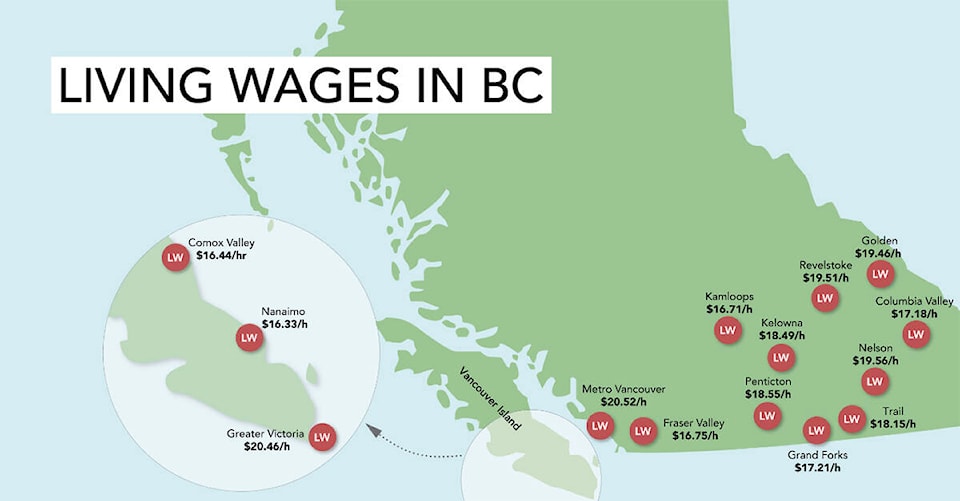It might be cheaper in the Comox Valley than in some cities, but the cost of living for families is going up.
That’s one finding from the most recent Living Wages in B.C. report, produced by Living Wage for Families BC and the Canadian Centre for Policy Alternatives.
The living wage is defined as the amount per hour each of two working parents must make to cover basic expenses such as housing, child care, food and transportation after taxes, deductions and subsidies are factored into the equation.
“The living wage is a powerful tool to address this troubling state of poverty amid fairly strong economic performance and growing wealth in B.C. It allows us to get serious about reducing child poverty and ensures that families that are working hard get what they deserve,” the report’s authors said.
The report includes data released simultaneously for 14 communities in the province. Metro Vancouver and Greater Victoria both saw increases over their 2019 amount and were the highest, at $20.52 and $20.46 per hour, respectively.
The Comox Valley, which was $15.97 in 2019, saw the figure rise to $16.44 for 2021. Because of the disruption from COVID-19 last year, there was no report, and the 2019 figure represented an unexpected drop over previous years.
RELATED STORY: Living wage drops in the Comox Valley
The $0.47 per hour jump from 2019 represents a hike in many expenses, especially housing in a tight market. The Comox Valley Social Planning Society points out the living wage figure uses the average amount that people pay for a three-bedroom home rather than the cost of new listings, which would push the number higher.
Still, the increase illustrates the difficulties many families are facing.
“The reality is that a number of families in the Comox Valley earn less than a living wage and struggle to make ends meet with the rising cost of living,” said Betty Tate from the Comox Valley Social Planning Society.
The report points out that more than 300 organizations across the province have become certified as “Living Wage Employers.” This includes more than 100 alone in 2021, perhaps in response to recent hiring challenges.
“The pandemic has revealed how much of our economy depends on undervalued and underpaid workers in service and care industries,” said Anastasia French of Living Wage for Families BC.
While many public sector employers have signed on to become Living Wage Employers, private sector employers are also responding. Tate says that in the Comox Valley, there are eight private or non-profit employers that have registered, including Hakai Energy Solutions, Tree Craft, Wayward Distillery, Motif Music Studios, Nikkei Ramen-ya, Bigfoot Donuts, Habitat for Humanity and West & Co. Consignment Boutique.
“We applaud them all and encourage other local employers to become certified,” she said.
Province responds
Courtenay-Comox MLA Ronna-Rae Leonard spoke about the last Living Wage report when it came out in 2019.
“Living Wage is an interesting concept,” she told the Record.
She said the figure represents an amount of a family of four with two working parents, though this does not represent everyone’s situation or experience.
However, it does provide a good comparison over how things change over time, and while the threshold has gotten higher in the last two years, the area is in a better situation than many around the province, and she is proud her government’s programs are connecting people with services they need, she says.
“There’s a whole laundry list of things that we’ve done,” she said.
Leonard points to measures such as raising minimum wage, cutting ICBC rates, eliminating Medical Services Plan premiums, and investing in education and trades training. She also said the government has responded to calls from local governments through the Union of British Columbia Municipalities to allow for changes to speed up the development process to increase the affordable housing supply.
As well, she is pleased local governments, such as the Comox Valley Regional District, are responding to challenges through measures such as poverty reduction strategies.
“I’m really proud of our community,” she said.
mike.chouinard@comoxvalleyrecord.com
Like us on Facebook and follow us on Twitter.
